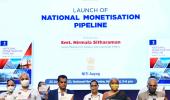The growth in the contact-intensive portion of the economy trailed our expectation, highlighting how imperative it is for confidence to improve, either through accelerated vaccinations or otherwise, to drive a sustainable recovery in these sectors, asserts Aditi Nayar.

India's real GDP expanded by a record-high 20.1 per cent in year-on-year (YoY) terms in Q1 FY2022, in line with our own forecast of 20.0 per cent.
As anticipated, the distorted base of last year's stringent nationwide lockdown obscured the devastation of the second wave of COVID-19 that was accompanied by staggered state-wise restrictions in Q1 FY2022.
Nevertheless, the sharp YoY expansion in that quarter is analytically misleading, as the real GDP in Q1 FY2022 not only posted a sequential slowdown of 16.9 per cent over Q4 FY2021, but also trailed the pre-Covid level of Q1 FY2020 by a considerable 9.2 per cent.
The NSO has pegged the GVA growth in Q1 FY2022 at 18.8 per cent, driven by the dizzying YoY expansion in industry (46.1 per cent), led by manufacturing (49.6 per cent) and construction (68.3 per cent), followed by a relatively sedate performance of services (11.4 per cent) and agriculture and allied activities (4.5 per cent).
The GVA growth in Q1 FY2022 is higher than our forecast of 17.0 per cent, led by the robust rabi harvest, and modestly better than expected performance of manufacturing, mining and construction.
Nevertheless, the growth in the contact-intensive portion of the economy trailed our expectation, highlighting how imperative it is for confidence to improve, either through accelerated vaccinations or otherwise, to drive a sustainable recovery in these beleaguered sectors.
On a sobering note, only agriculture and electricity posted a higher GVA in real terms in Q1 FY2022, relative to their pre-covid performance.
On the expenditure side, private consumption and investment powered the YoY turnaround in the GDP performance, with an expansion of 19.3 per cent and 55.3 per cent, respectively.
While the central bank's consumer confidence survey had revealed a sombre trend in the wake of the second wave of COVID-19, resilient farm demand buffered private consumption to an extent in Q1 FY2022.
Higher capital spending by the Centre and states, and an improvement in project announcement and completion, boosted investment activity on a YoY basis in the just-concluded quarter. Nevertheless, both private consumption and investment remained well below their pre-covid levels in Q1 FY2022.
In contrast, while government consumption expenditure recorded a YoY contraction of 4.8 per cent in Q1 FY2022, emerging as a drag on the pace of growth, it exceeded the pre-Covid level by a healthy 7.4 per cent.
So, what does this deceptively high GDP expansion portend for monetary policy?
The Q1 FY2022 GDP growth is mildly lower than the Monetary Policy Committee's own forecast of 21.4 per cent. As a result, we expect the status quo to continue until strengthening domestic demand replaces supply-side constraints as the key driver of inflationary pressures.
We expect policy normalisation to commence in February 2022, with a change in the stance of monetary policy to neutral from accommodative.
Globally, the spread of the Delta variant has renewed uncertainty about the sustainability of demand and arrested the rise in commodity prices.
Domestically, high frequency indicators foretell a deepening recovery in Q2 FY2022, driven by the easing of state-wise restrictions and growing confidence led by widening vaccination coverage.
Moreover, the 15 per cent shortfall in rainfall in July-August 2021 has afforded a longer window for construction and mining activities.
Interestingly, while the negative impact of deficient rainfall on agricultural activities will be contained by healthy reservoir levels, a higher requirement for groundwater for irrigation has actually pushed up the electricity demand, which will boost the GVA growth in Q2 FY2022.
We expect GDP growth in the ongoing quarter to range between 7.8-8.8 per cent, with the absolute level of GDP mildly trailing the pre-pandemic performance on account of a delayed recovery in the services sector.
Subsequently, we expect Indian real GDP to exceed the pre-pandemic levels in H2 FY2022, with the extent of the upside to be dictated by whether the recent acceleration in vaccine administration is sustained.
Aditi Nayar is chief economist, Icra. Views are personal.












 © 2025
© 2025